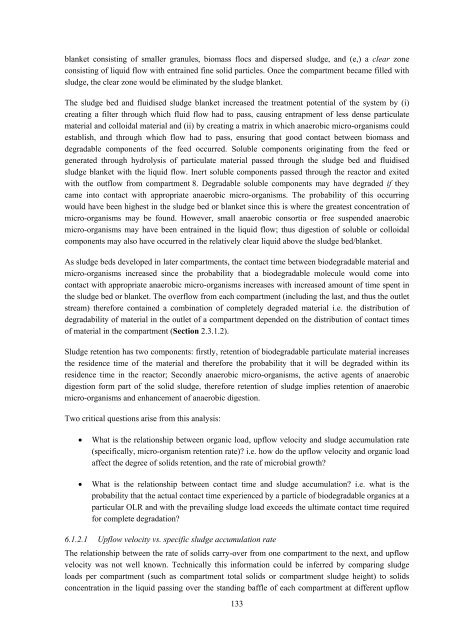analysis of a pilot-scale anaerobic baffled reactor treating domestic ...
analysis of a pilot-scale anaerobic baffled reactor treating domestic ...
analysis of a pilot-scale anaerobic baffled reactor treating domestic ...
Create successful ePaper yourself
Turn your PDF publications into a flip-book with our unique Google optimized e-Paper software.
lanket consisting <strong>of</strong> smaller granules, biomass flocs and dispersed sludge, and (e,) a clear zone<br />
consisting <strong>of</strong> liquid flow with entrained fine solid particles. Once the compartment became filled with<br />
sludge, the clear zone would be eliminated by the sludge blanket.<br />
The sludge bed and fluidised sludge blanket increased the treatment potential <strong>of</strong> the system by (i)<br />
creating a filter through which fluid flow had to pass, causing entrapment <strong>of</strong> less dense particulate<br />
material and colloidal material and (ii) by creating a matrix in which <strong>anaerobic</strong> micro-organisms could<br />
establish, and through which flow had to pass, ensuring that good contact between biomass and<br />
degradable components <strong>of</strong> the feed occurred. Soluble components originating from the feed or<br />
generated through hydrolysis <strong>of</strong> particulate material passed through the sludge bed and fluidised<br />
sludge blanket with the liquid flow. Inert soluble components passed through the <strong>reactor</strong> and exited<br />
with the outflow from compartment 8. Degradable soluble components may have degraded if they<br />
came into contact with appropriate <strong>anaerobic</strong> micro-organisms. The probability <strong>of</strong> this occurring<br />
would have been highest in the sludge bed or blanket since this is where the greatest concentration <strong>of</strong><br />
micro-organisms may be found. However, small <strong>anaerobic</strong> consortia or free suspended <strong>anaerobic</strong><br />
micro-organisms may have been entrained in the liquid flow; thus digestion <strong>of</strong> soluble or colloidal<br />
components may also have occurred in the relatively clear liquid above the sludge bed/blanket.<br />
As sludge beds developed in later compartments, the contact time between biodegradable material and<br />
micro-organisms increased since the probability that a biodegradable molecule would come into<br />
contact with appropriate <strong>anaerobic</strong> micro-organisms increases with increased amount <strong>of</strong> time spent in<br />
the sludge bed or blanket. The overflow from each compartment (including the last, and thus the outlet<br />
stream) therefore contained a combination <strong>of</strong> completely degraded material i.e. the distribution <strong>of</strong><br />
degradability <strong>of</strong> material in the outlet <strong>of</strong> a compartment depended on the distribution <strong>of</strong> contact times<br />
<strong>of</strong> material in the compartment (Section 2.3.1.2).<br />
Sludge retention has two components: firstly, retention <strong>of</strong> biodegradable particulate material increases<br />
the residence time <strong>of</strong> the material and therefore the probability that it will be degraded within its<br />
residence time in the <strong>reactor</strong>; Secondly <strong>anaerobic</strong> micro-organisms, the active agents <strong>of</strong> <strong>anaerobic</strong><br />
digestion form part <strong>of</strong> the solid sludge, therefore retention <strong>of</strong> sludge implies retention <strong>of</strong> <strong>anaerobic</strong><br />
micro-organisms and enhancement <strong>of</strong> <strong>anaerobic</strong> digestion.<br />
Two critical questions arise from this <strong>analysis</strong>:<br />
• What is the relationship between organic load, upflow velocity and sludge accumulation rate<br />
(specifically, micro-organism retention rate)? i.e. how do the upflow velocity and organic load<br />
affect the degree <strong>of</strong> solids retention, and the rate <strong>of</strong> microbial growth?<br />
• What is the relationship between contact time and sludge accumulation? i.e. what is the<br />
probability that the actual contact time experienced by a particle <strong>of</strong> biodegradable organics at a<br />
particular OLR and with the prevailing sludge load exceeds the ultimate contact time required<br />
for complete degradation?<br />
6.1.2.1 Upflow velocity vs. specific sludge accumulation rate<br />
The relationship between the rate <strong>of</strong> solids carry-over from one compartment to the next, and upflow<br />
velocity was not well known. Technically this information could be inferred by comparing sludge<br />
loads per compartment (such as compartment total solids or compartment sludge height) to solids<br />
concentration in the liquid passing over the standing baffle <strong>of</strong> each compartment at different upflow<br />
133
















